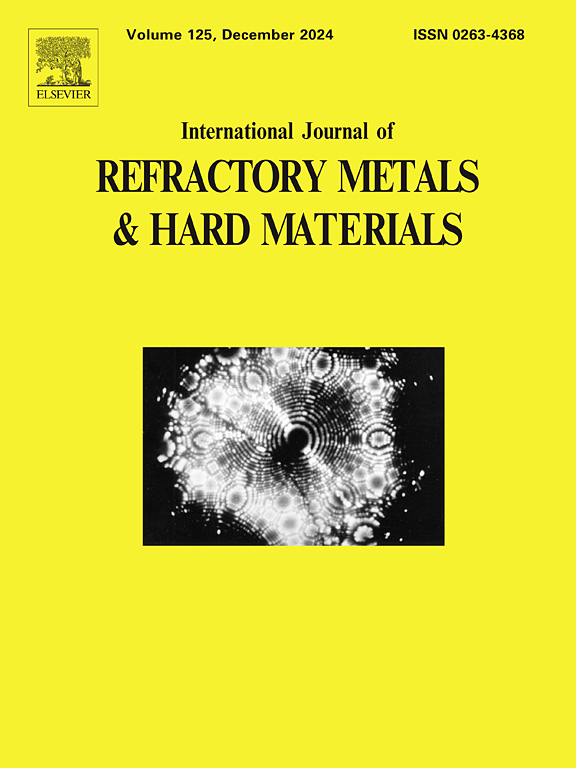Investigation of microstructural evolution and property optimization of pure tungsten via powder extrusion 3D printing
IF 4.2
2区 材料科学
Q2 MATERIALS SCIENCE, MULTIDISCIPLINARY
International Journal of Refractory Metals & Hard Materials
Pub Date : 2025-02-10
DOI:10.1016/j.ijrmhm.2025.107088
引用次数: 0
Abstract
Powder extrusion printing (PEP) of tungsten addresses the limitations of residual stress cracking and the high costs associated with direct 3D printing of powder materials. It shows significant potential for producing tungsten products with complex geometries. In this study, green parts made from fine and medium-sized tungsten powders were fabricated using PEP, followed by solvent-thermal debinding and vacuum sintering to create samples with varying densities. The rheological behavior of both feedstock, process parameters affecting print quality, solvent debinding, and microstructural evolution during sintering were investigated. The results indicate that the viscosity of fine tungsten powder feedstock is higher and more sensitive to temperature changes. Key factors influencing print quality include layer thickness, nozzle diameter, and printing speed. Solvent debinding progresses from the sample's edge towards its center, with the debinding rate primarily governed by solute dissolution and diffusion. After sintering at 1750 °C, the relative density of medium-sized tungsten powder reached only 74.0 %, whereas the fine powder achieved a density of 96.8 %. These findings confirm that extrusion 3D printing, combined with sintering, is an effective method for producing high-density tungsten parts with intricate shapes.
通过粉末挤压 3D 打印研究纯钨的微结构演变和性能优化
钨的粉末挤压打印(PEP)解决了残余应力开裂和粉末材料直接3D打印相关的高成本的局限性。它显示出生产具有复杂几何形状的钨制品的巨大潜力。在本研究中,采用PEP方法制备了由细、中型钨粉制成的绿色部件,然后采用溶剂-热脱脂和真空烧结制备了不同密度的样品。研究了两种原料的流变行为、影响打印质量的工艺参数、溶剂脱粘以及烧结过程中的微观结构演变。结果表明,细钨粉原料粘度较高,对温度变化较为敏感。影响打印质量的关键因素包括层厚、喷嘴直径和打印速度。溶剂脱粘是由样品的边缘向中心进行的,脱粘速率主要由溶质溶解和扩散决定。在1750℃烧结后,中型钨粉的相对密度仅为74.0%,而细粉的相对密度为96.8%。这些发现证实,挤压3D打印与烧结相结合,是生产具有复杂形状的高密度钨零件的有效方法。
本文章由计算机程序翻译,如有差异,请以英文原文为准。
求助全文
约1分钟内获得全文
求助全文
来源期刊
CiteScore
7.00
自引率
13.90%
发文量
236
审稿时长
35 days
期刊介绍:
The International Journal of Refractory Metals and Hard Materials (IJRMHM) publishes original research articles concerned with all aspects of refractory metals and hard materials. Refractory metals are defined as metals with melting points higher than 1800 °C. These are tungsten, molybdenum, chromium, tantalum, niobium, hafnium, and rhenium, as well as many compounds and alloys based thereupon. Hard materials that are included in the scope of this journal are defined as materials with hardness values higher than 1000 kg/mm2, primarily intended for applications as manufacturing tools or wear resistant components in mechanical systems. Thus they encompass carbides, nitrides and borides of metals, and related compounds. A special focus of this journal is put on the family of hardmetals, which is also known as cemented tungsten carbide, and cermets which are based on titanium carbide and carbonitrides with or without a metal binder. Ceramics and superhard materials including diamond and cubic boron nitride may also be accepted provided the subject material is presented as hard materials as defined above.

 求助内容:
求助内容: 应助结果提醒方式:
应助结果提醒方式:


